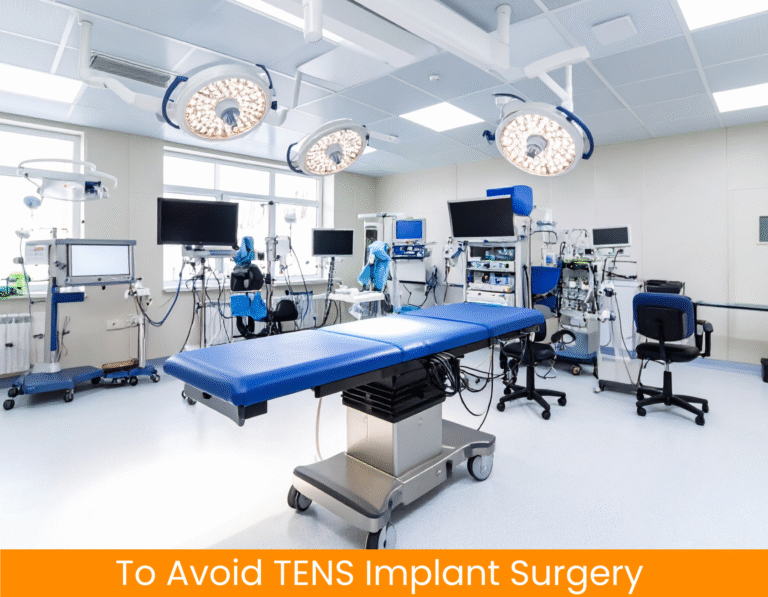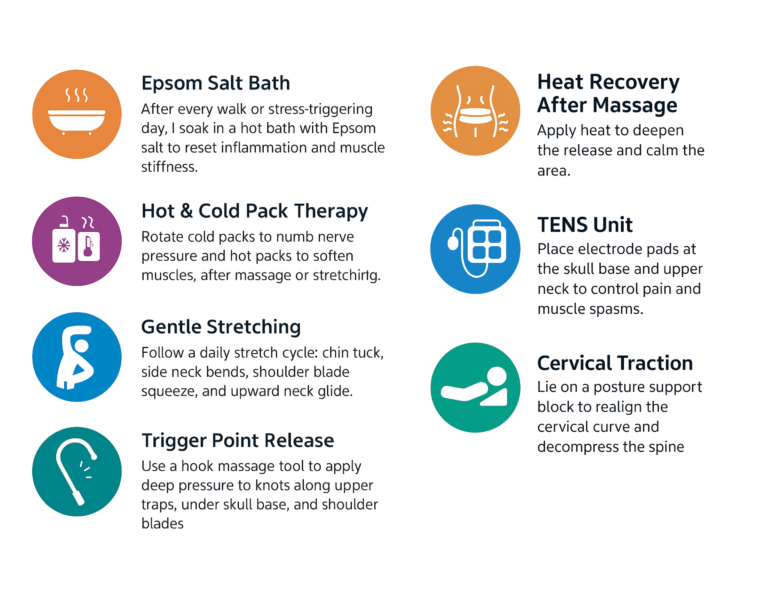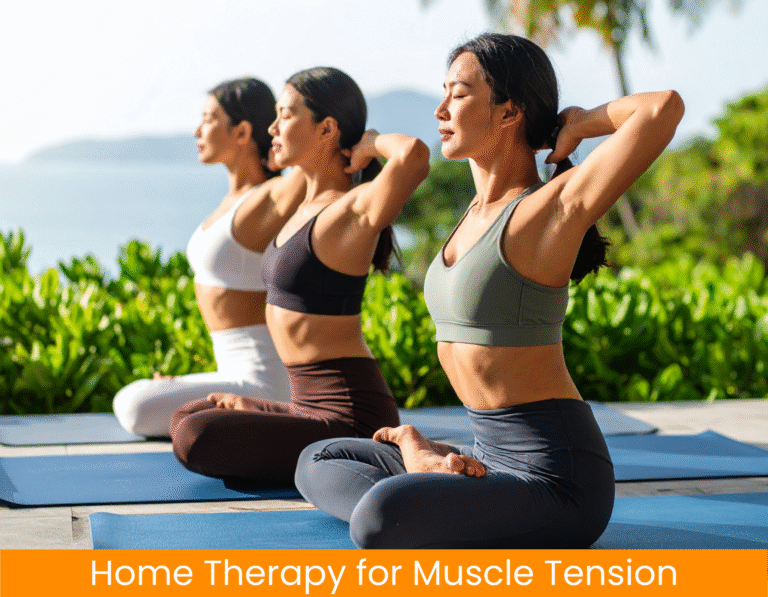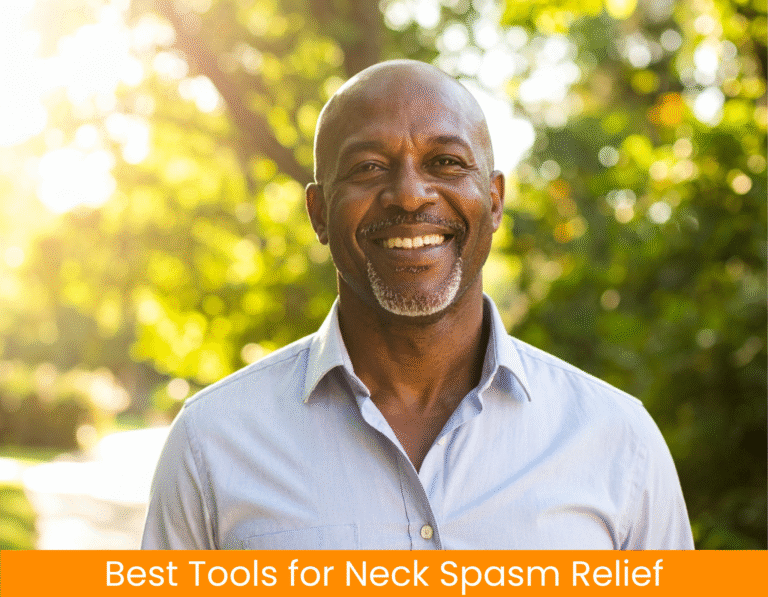

Relieve Migraine Headaches & Neck Muscle Spasms at Home
Functional Health and Wellness by Samuel
My Journey to Relieve Migraine Headaches & Neck Muscle Spasms at Home
If you’re someone who suffers from migraine headaches and neck muscle spasms, you’re not alone. This article is for anyone looking to relieve migraine headaches and neck muscle spasms at home—whether your pain stems from surgery, stress, posture, or everyday strain.—and more importantly, there is real hope. My journey began after multiple spinal procedures, but I soon realized these painful symptoms weren’t exclusive to spinal injuries. Today, more people—especially aging adults, frequent travelers, and those with tech-heavy lifestyles—are dealing with tight neck muscles, cervicogenic headaches, and recurring spasms caused by stress, poor posture, and daily strain.
I recently shared a guide on the Best Walking Shoes for Spinal Injury Recovery. That post covered how I relearned to walk after 17 spinal surgeries and procedures. This post is just as personal. It shares the pain relief routine that helped me not only reduce my reliance on medications like Tylenol 3 and Tramadol—but also break out of chronic pain cycles that once lasted for days if not weeks.
I developed this home therapy protocol to avoid surgical TENS implants. Over time, it worked. Today, it continues to help friends, family, and others experiencing migraine pain, cervical nerve compression, tension headaches, and upper back spasms.
If you’ve ever felt stuck between chronic pain and a list of failed treatments, this article is for you.
Why Cervicogenic Headaches & Neck Spasms Affect So Many People

Cervicogenic headaches stem from nerve irritation and muscle dysfunction in the upper spine, neck, and shoulders. These headaches often mimic migraines and radiate pain behind the eyes or down through the shoulder blades. While some people develop these symptoms after injury, many experience them due to long hours at a desk, poor sleep, high stress, or constant screen time.
According to the NCBI Bookshelf, cervical dysfunction and postural stress are best managed through stretching, manual therapy, and mobility exercises.
I used to get stuck in 3 to 7 day pain spirals that felt impossible to break. At my worst, I couldn’t even hold my head upright without triggering migraine-like pain. That’s when I knew I had to try something different..
Why I Refused a TENS Implant and Built My Own Recovery System

After trying nerve blocks, trigger point injections, and prescription medications, my pain management doctor, Dr. Reginal Ajakwe, suggested a spinal cord stimulator. But for me, an implant wasn’t the answer—not after 17 surgeries and procedures. I needed to exhaust every conservative option first.
According to PubMed, complications from implanted TENS devices are common and include infection, lead migration, and long-term hardware issues. Many patients end up removing them altogether.
I didn’t want that to be me. So I developed this structured, at-home therapy plan—and stuck with it. I’m still fighting, but this routine helps me stay ahead of the pain.
My 7-Step Routine to Relieve Migraine Headaches & Neck Muscle Spasms

These are the methods I use every day to relieve migraine headaches and neck muscle spasms at home. Each step targets pain, inflammation, and nerve tension—before they escalate into debilitating episodes. With consistency, this plan can reduce your dependence on medications and help you feel functional again.—before they escalate into debilitating migraines. Backed by clinical studies and personal experience, this protocol continues to help others regain control over their pain.
As an Amazon Associate, I earn from qualifying purchases. The links in this article point to the actual tools I used during recovery.
Part 1: Relax, Release, and Reset the Muscles (Steps 1–4)
These first four steps are focused on loosening tight muscles, reducing inflammation, and releasing trapped tension.. Backed by clinical studies and personal experience, this protocol continues to help others regain control over their pain.
1. Epsom Salt or Magnesium Bath
I soak in a hot bath with Ancient Minerals Magnesium Bath Flakes for 20–30 minutes, 3–4 times a week. This helps reset inflammation, relax nerves, and soften tight muscles—especially after stress or long walks.
2. Hot & Cold Pack Therapy
Cold packs reduce nerve pain. I alternate with heat using the SunnyBay Lava Sand Hot Pack to relax the muscle tissue. These 20-minute cycles, especially after stretching or massage, calm flare-ups and reduce inflammation.
3. Gentle Stretching for Postural Relief
I stretch in four directions—chin tucks, side neck bends, shoulder blade squeezes, and upward glides. I perform 4 sets of 20 reps twice daily. This restores mobility, improves blood flow, and relieves muscular tension caused by long hours at a desk or poor sleep.
4. Trigger Point Release with a Massage Hook
The Liba Trigger Point Massage Hook is my go-to for deep pressure. I use it on knots at the base of my skull, between my shoulders, and under the traps—firmly holding pressure for 15–20 seconds per spot.
From experience, I follow a strict rule: on day one, never go beyond 2 minutes total. If you push past that, the pain can worsen after the muscle settles. It might feel manageable at first, but the soreness can hit hard later. I learned the hard way, which is why I advise starting slow and increasing gradually—about one minute more each day as your body allows.
Massage guns can help, but for me, nothing beats the precision of the Liba Hook. It has consistently been the most effective tool I’ve used to break down deep, long-standing knots and stop spasms before they spread. (Clinical support: JPTS – Trigger Point Compression)
These first four steps are foundational to relieve migraine headaches and neck muscle spasms at home.. It has consistently been the most effective tool I’ve used to break down deep, long-standing knots and stop spasms before they spread. (Clinical support: JPTS – Trigger Point Compression)

Part 2: Activate Nerve Relief and Restore Alignment (Steps 5–7)
These final three steps use heat, electrical stimulation, and spinal support to calm nerve pain and improve long-term recovery.
5. Heat Recovery After Massage
Right after releasing knots, I reapply heat for 10 minutes. This calms the tissue, prevents rebound tension, and extends relief.
6. TENS Unit for Spasm and Nerve Control
This step was a complete game-changer in my recovery. Instead of an implant, I use the Roscoe Medical TENS Unit—a portable machine that delivers low-voltage electrical pulses through electrode pads placed at the base of my neck. I typically run one to two 30-minute cycles depending on pain severity, especially after trigger point release.
TENS therapy works in two ways: it blocks pain signals from reaching the brain and stimulates the release of endorphins, your body’s natural painkillers. What makes this powerful is that it helps relax my neck and shoulder muscles without drugs. I can walk, stretch, or even work while getting treatment—it keeps me functional even during flare-ups.
This was the turning point that helped me reduce dependency on medications like Tylenol 3 and Tramadol. With consistent use, I’ve shortened recovery time from pain spirals and avoided additional nerve blocks or interventions.
According to WebMD – TENS for Back Pain, TENS therapy sends low-voltage impulses that disrupt pain signals and stimulate endorphins. It’s widely used for back pain, neck spasms, and nerve sensitivity.
7. Cervical Traction or Neck Support Block
I lie on the StrongTek Cervical Traction Block for 20 minutes after massage or TENS. It realigns my cervical spine and decompresses the area while the muscles are relaxed and receptive.
When I can’t complete the full routine, I focus on just two essentials: the Liba Hook and the TENS unit. These two alone have helped me break pain cycles faster than anything else I’ve tried.
Final Thoughts on How to Relieve Migraine Headaches & Neck Muscle Spasms at Home

If you struggle with neck tightness, cervicogenic headaches, or stubborn migraines, you don’t have to rely on surgery or daily medications. This routine isn’t a miracle cure—but it’s the difference between feeling helpless and having control.
It’s helped aging adults, office professionals, spinal patients, and even travelers manage chronic tension and nerve pain. Adjust it to fit your body. Start small. Stay consistent. If you’re looking for a proven way to relieve migraine headaches and neck muscle spasms at home, this 7-step plan can guide you.
You don’t have to live in constant pain. Start with one step—and build your way back to relief.